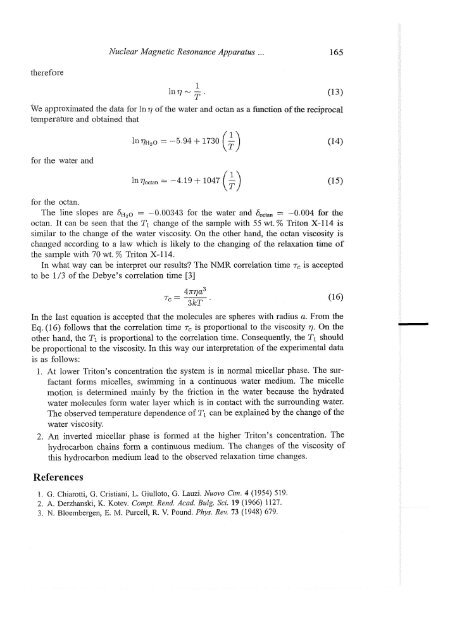R. Marinov, K. Shoumarov, A. Derzhanski.NuclearMagnetic ...
R. Marinov, K. Shoumarov, A. Derzhanski.NuclearMagnetic ...
R. Marinov, K. Shoumarov, A. Derzhanski.NuclearMagnetic ...
Create successful ePaper yourself
Turn your PDF publications into a flip-book with our unique Google optimized e-Paper software.
Nuclear Magnetic Resonance Apparatus l 65<br />
therefore<br />
1<br />
~ In T n - . (13)<br />
Wle approximated the data for In 77 of the water and octan as a function of the reciprocal<br />
temperature and obtained that<br />
for the water and<br />
=- ( )<br />
1<br />
Innkl o 5.94 + 1730 T (14)<br />
=- ( )<br />
1<br />
Innoctan 4.19+1047 T (15)<br />
for the octan.<br />
The line slopes are 61{20 = -0.00343 for the water and 60ctan = ~0.004 for the<br />
octan. It can be seen that the Tl change of the sample with 55 wt. % Triton X-114 is<br />
similar to the change of the water viscosity. On the other hand, the octan viscosity is<br />
changed according to a law which is likely to the changing of the relaxation time of<br />
the sample with 70 wt. o/o Triton X-1 14.<br />
In what way can be interpret our results? The NMR correlation time Tc is accepted<br />
to be I /3 of the Debye's correlation time [3]<br />
47Tna3<br />
Tc- 3kT ' (16)<br />
In the last equation is accepted that the molecules are spheres with radius a. From the<br />
Eq. (16) follows that the correlation time Tc is proportional to the viscosity n. On the<br />
other hand, the T1 is proportional to the correlation time. Consequently, the T1 should<br />
be proportional to the viscosity. In this way our interpretation of the experimental data<br />
is as follows:<br />
1 . At lower Triton's concentration the system is in nonnal micellar phase. The surfactant<br />
forms micelles, swinuning in a continuous water medium. The micelle<br />
motion is determined mainly by the friction in the water because the hydrated<br />
water molecules fonu water layer which is in contact with the surrounding water.<br />
The observed temperature dependence of T1 can be explained by the change of the<br />
water viscosity.<br />
2. An inverted micellar phase is fonned at the higher Triton's concentration. The<br />
hydrocarbon chains fonn a continuous medium. The changes of the viscosity of<br />
this hydrocarbon medium lead to the observed relaxation time changes.<br />
References<br />
1. G. Chiarotti, G. Cristiani, L. Giulloto, G. Lauzi. Nuovo Ciln. 4 (1954) 519.<br />
2. A. <strong>Derzhanski</strong>, K. Kotev. Compt. Rend. Acad. Bulg. Sci. 19 (1966) I 127.<br />
3. N. Bloembergen, E. M. Purcell, R. V. Pound. Phys. Rel~ 73 (1948) 679.


